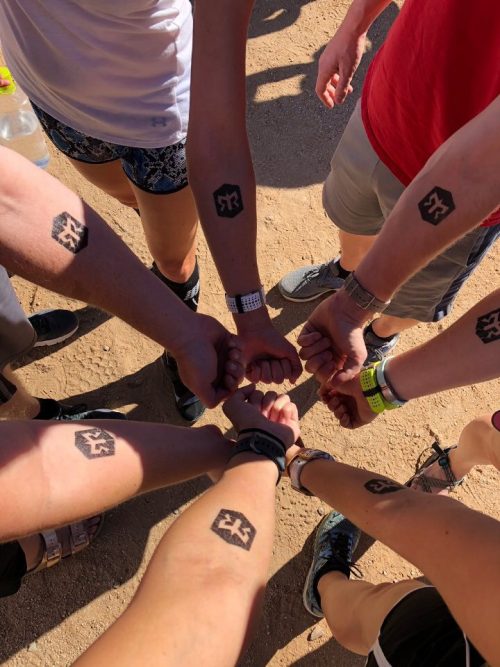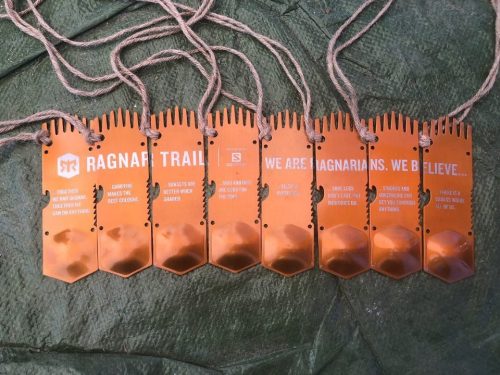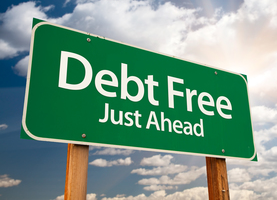by Ashley
This post is more of a “life” post than a strictly financial one. If you’re not into the “life” stuff, feel free to skip it.
I finished my second Ragnar race last week!
If you’re not familiar, Ragnar is a relay-style race where participants run for 24+ hours. We ran at McDowell Mountain, which is a trail run (there are trail races & road races). At this race, each participant runs about 16 miles, split up into 3 different legs, an “easy” leg, a “moderate” leg, and a “hard” leg.
I fancy myself a runner (though I’m incredibly slow…but I enjoy it and it’s something I do regularly, so even if I’m not speedy or great at running…..I still consider myself a “runner”). It was something I first got “into” when I first moved to Arizona 10 years ago and I’ve done it basically ever since. I usually participate in about 1 “big” race every year or so, and I do a handful of shorter distances each year (maybe one 5K and one 10K on average, plus in our area there are free Kids’ Mile races so I do 2-3 of those each year with my kids and they’re super fun! The kids still get shirts and medals and post-race food and drinks, etc. and it’s literally 100% free! So there <<< I still have a financial connection in this post, lol)
Even though I like to think of myself as a “runner,” preparing for this type of event is a PROCESS for me. It’s been interested to see how my teammates have approached it, as I’ve now done it twice. Several of my teammates across the two years have basically shown up with very minimal training and crushed it, no problem (though, in fairness, they are in-shape and participate in other types of exercise like rock-climbing, tennis, etc.) For me, it’s a 3-month long ordeal where I run 4-5/week and train my body to handle the long distance runs; then adding in 2-a-day runs, etc. It’s a lot of fun, though, as we often organize Team Runs and there’s a lot of camaraderie involved.
I debated whether to drop from the team multiple times this year. I didn’t feel well enough prepared. I was slower than everyone else. I missed an entire week of training when I got Kidney Stones. It just didn’t feel like a good time in my life. For much of training, I was right in the middle of my move, separation-related stress, and general life chaos. It felt like taking time to run was a luxury I could not afford.
But then……maybe the training occurred at the perfect time in my life, too. Maybe I needed those mental “breaks” to just be out running. And the connection with my teammates, feeling their support and friendship.
Funny how sometimes the thing you think you just CANNOT do, is the exact thing you NEED to do for yourself in that moment in time.


We were slower this year than last (last year we finished in 23 hours, this year we were at 25 hours), but I felt stronger this time, had less soreness in the aftermath, and it was the same amount of fun.
COST:
In all honesty, I can’t remember the exact costs and registration isn’t open for next year yet so I can’t see what the current cost is. I know our team registered early so we got a price break and I want to say it cost $60 or $70 per person. I did buy some new running shoes (about $100), but the rest of my running gear I have owned for awhile.
Overall, I think my running hobby is pretty inexpensive. Most of my “running” related accessories have be re-used for years. I’ve had the same fuel belt for probably 5 years, for example. I’ve had the same headphones and headlamp (for night running) for over 2 years. Many of my running compression socks, sweat-wicking headbands and hats I’ve owned for a number of years, etc. And all of my training runs are free. I either run at trails by my house or the team has met up for trail runs at a local trailhead (also free). Given that I train for the race for a solid 3 months in preparation, that $60-70 entry fee amounts to 3 months of “entertainment” and team-building leading up to the big race. Not to mention the potential psychological benefits of getting exercise and Vitamin D, and of being able to unplug and be outside for awhile. It’s pretty powerful.
I’m 99% sure I’ll be joining the team for Ragnar 2019, too. I guess it’s just become an annual tradition at this point. 🙂

Hi, I’m Ashley! Arizonan on paper, Texan at heart. Lover of running, blogging, and all things cheeeeese. Freshly 40, married mother of two, working in academia. Trying to finally (finally!) pay off that ridiculous 6-digit student loan debt!

